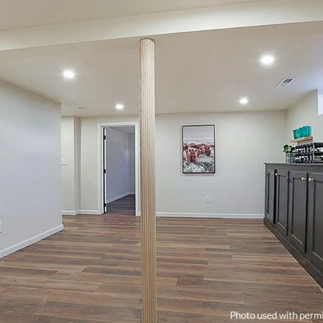Case Study: Middleton Basement Remodel
- juliaw650

- Mar 25, 2024
- 4 min read
Transforming an unfinished basement into a functional and appealing space is one of the most sought-after services we offer at Bouril Design. Not only does this service significantly increase the value of your home, but it also provides an opportunity for complete customization based on your family’s unique lifestyle and goals. While the construction process can seem daunting, particularly with considerations like city-required submissions, our team is well-equipped to guide you through every step of the way.
Recently, we had the pleasure of collaborating on a basement remodel project for a client who was no stranger to such projects. She possessed experience in coordinating with contractors and desired to apply her own interior design skills to the project. However, precise drawings for city permits and advice on optimizing the basement’s square footage were areas where she sought our expertise.
The initial step in our process involves reaching out to us to arrange an introductory meeting, which can also include a site visit if necessary. This meeting serves as a crucial opportunity for both parties to get acquainted and determine if our firm is the right fit for your project. It allows us to gain a deeper understanding of your needs, goals, and vision while also providing you with insights into our firm's approach and capabilities.
During the site visit, we take a comprehensive walkthrough of the project area with you to address any lingering questions about the project's direction. Simultaneously, we meticulously document the current project conditions, which serve as the foundational blueprint for our subsequent construction drawings. This documentation process involves capturing detailed photographs of both the exterior and interior of the home, precise measurements of walls and openings, and noting key structural elements such as drop beams and column placements. With this wealth of data at hand, we proceed to create a precise 3D model of the existing home, marking the initiation of the concept design phase.

In the case of this particular client, the goal was to integrate an additional bedroom into the basement while already having rough plumbing in place for a full bathroom. As we delved deeper into the design process, we encountered several existing features of the house that required careful consideration. For instance, there was a raised concrete section in one corner, which conveniently aligned with the dimensions needed for a linen closet. This decision not only resolved the challenge posed by the raised slab but also streamlined the overall design process.

However, challenges such as a steel drop beam and post that couldn't be relocated, along with the client's desire to retain dry bar cabinetry, presented additional hurdles. The most significant challenge, though, stemmed from the basement's low ceiling height, falling short of the Uniform Dwelling Code (UDC) requirement of seven feet. Our measurements revealed a height of six feet ten inches, prior to factoring in flooring and ceiling finishes.
Navigating through municipal regulations to secure approvals for such projects becomes paramount in ensuring a smooth progression. Our client, for instance, required approval from Middleton authorities to proceed with the project. This necessitated the submission of detailed floor plans for both the existing layout and proposed renovations. This phase of regulatory compliance formed a significant portion of our involvement in the project.
Gone are the days when simple sketches on napkins sufficed for building permits. Today, most municipalities mandate detailed scale drawings of floor plans and site plans as a minimum requirement for approving new construction or renovations. While it may seem feasible for anyone to purchase design software and review building codes, the intricacies involved often demand professional expertise. Our office specializes in residential dwellings, leveraging our knowledge and streamlined workflow to efficiently navigate through such projects.
Our strategy in securing approvals involved showcasing the planned addition of an egress window and interconnected fire alarms, both essential elements mandated by building codes for a bedroom. This not only ensured compliance with safety standards but also demonstrated that the lower ceiling height would not pose an additional safety concern. Municipalities are cognizant of the challenges posed by older homes in meeting modern codes and regulations. Thus, they often provide leeway for reasonable renovations that balance safety concerns with homeowners' aspirations to enhance property value and functionality.
Our collaborative approach with clients extends beyond design and regulatory compliance. During initial meetings and site visits, we educate clients about what to expect in terms of regulatory requirements and feasible design solutions. However, it's crucial to note that each municipality operates differently, and interpretations of codes and ordinances can vary. Sometimes, even decisions can hinge on the personnel managing the approvals on a particular day.

The addition of the egress window not only addressed safety requirements but also introduced natural light and ventilation into the basement space. Despite being the most invasive aspect of the remodel, involving cutting through concrete foundation walls, egress windows are meticulously designed to meet specific opening requirements for safe emergency exits. Additionally, egress wells are constructed to facilitate safe egress from the well to the exterior, further enhancing safety measures.
Crafting a comprehensive site plan that aligns with zoning regulations is another crucial aspect of our work. This becomes especially pertinent when integrating elements like egress wells, which have specific requirements regarding placement and design. While an updated survey wasn't deemed necessary in this particular project due to favorable distances from setbacks, we leveraged publicly available GIS data as the basemap for our site plan, ensuring accuracy and adherence to regulations.
While our client took on the responsibilities of construction administration and interior design independently, our involvement was pivotal in guiding her through critical phases of the project. From providing insights on layout options and navigating city permissions to producing detailed drawings for city submissions and contractor references, our expertise complemented her efforts seamlessly. Moreover, our emphasis on educating clients about relevant building codes and regulations enhances their awareness and confidence in undertaking future remodels or construction projects.
At Bouril Design, we pride ourselves on simplifying complex basement remodel processes for clients with varying skill levels. Whether you're a seasoned DIY enthusiast or new to home renovations, our team is committed to guiding you through each step seamlessly. Reach out to us today to discuss your upcoming home remodel project with one of our experienced staff members and embark on a journey towards transforming your basement into a functional and inviting space that aligns perfectly with your vision and lifestyle.














Commenti